
Wine Culture and Information since 2002 - Volume 22
 Wine Culture and Information since 2002 - Volume 22 |
|
Issue 119, June 2013 |
Contents |
|
|
Wine is Just Sulfur Dioxide |
|
Before discussing about the evident provocation of the title, it is the case to state a rightful introduction: sulfur dioxide is not a healthy substance, a condition determined, as usual, by the quantity being used, by the use and the abuse. Sulfur dioxide is not even the absolute evil of wine - something someone is trying to support in many occasions - by recognizing to this substance the discriminating power capable of defining a good and genuine wine or a bad and adulterated one. One more rightful statement: as health is a subject of evident collective interest - everyone wishes oneself to live in good health - it is also evident a healthy wine is something of collective interest, both “honest” producers and consumers, with no exception. Therefore, if it is true sulfur dioxide can be a harmful substance for the body - in particular, for those subjects particularly sensitive to this element - the reduction of its usage is of course something to be wished in order to have a healthier wine. If we see what is happening in the world of wine in recent years, it seems there is a war going on against sulfur dioxide - sometimes being cut-throat as well - something never seen in the past, something never seen for any other beverage or food. Sulfur dioxide is widely used by food and beverage industry, sometimes used in quantity higher than what it is usually done for wine, nevertheless, it does not seem this is arising the very same outcry, the same cut-throat opposition happening for wine. It would make no sense to give an example of foods and beverages in which sulfur dioxide is widely used: the list would be extremely long and boring. Moreover, in order to realize how sulfur dioxide is used in foods and beverages, it is enough to do what it is not usually done when you go to a shop: reading the list of ingredients printed on the label of those products we easily, and with too much trust, put in a carriage. It is not difficult to find that out: the most frequent indications include “sulfur dioxide”, “contain sulfites”, or the famous European codes beginning with the “E” letter, followed by numbers going from 220 to 229, a category identifying sulfites, commonly used as preservatives, with the exception of calcium bisulfite (E227) also having thickening properties. For the sake of completeness, potassium metabisulfite, that is the substance mainly used in wine making for the production of sulfur dioxide, is identified with the code “E224”. Nevertheless, no one, maybe just few, make objections on some products in which are evidently present sulfites used as a preservative. We happily buy them, we take them home and we consume them with satisfaction and pleasure. Wine is different: in the poor beverage of Bacchus, even the minimum suspect of the presence of sulfites can cause endless arguments, even blaming the producer of adulterating the wines, as if it was a crime. It is then a big surprise to find out sulfur dioxide is naturally found in wine and also in case this substance is not added by man, yeast produces sulfur dioxide during fermentation. It should be said the production of sulfur dioxide made by yeast during fermentation can also reach 40mg per liter - depending on the type - however the average quantity if about 20-25mg per liter. A quantity evidently lower than what it is usually added during production that - it should be noticed - is set by law and it is 200mg per liter for white wines and 150mg for red wines. Once again, for the sake of clearness, it should be said the maximum quantity set by law is rarely reached and - in good viticultural and wine making conditions - the quantity is even lower than the half. Let me say this clear: I am not trying to justify or supporting the use of sulfur dioxide in wine making, I am simply stating concrete facts. The use of sulfur dioxide in wine making is a very ancient practice: not only it was used as a preservative of wine and in order to sanify it, but also for sanifying wine tanks and the rooms where it was being produced wine. Before the introduction of potassium metabisulfite, sulfur dioxide was produced by burning sulfur pills, a practice, used since many centuries, which can also be considered traditional. This practice - to which is usually recognized a romantic and genuine meaning - is indeed quite difficult to control as it is not possible to know the exact quantity of sulfur dioxide added to the wine. The use of modern and evil potassium metabisulfite offers a better control, as every gram produces about 0.55 grams of sulfur dioxide. In conclusion, despite potassium metabisulfite is considered the absolute evil of wine, this allows a conscious and judicious use of sulfur dioxide. We all agree on the fact sulfur dioxide is not he healthiest of the substances and limiting its use in wine making it is desirable, also by considering the property of this element to alter the organoleptic profile of a wine. I am suspecting the war against sulfur dioxide is just a new “wine fashion”, a subject of which everyone can talk about, also with in a simple way and without having any specific competence in wine making: after all, if everyone is talking about this, there must be a reason. It is something everyone talk about as if this is the main problem of wine - indeed, the worst of them all - even though, in my opinion, I believe the real problems of the world of wine are elsewhere and it is convenient to keep them hidden. Producers, as they are legitimately trying to make a profit from their job, follow this fashion and start to make wines by emphasizing the fact they do not contain added sulfites. There is also who, cunningly, say their wines do not contain sulfites, a pretty improbable condition, as yeast however produce this substance. My point of view is still the same, also in this case: glass at hand, I want the wine to be evaluated by my senses, without the conditioning of words and fashions. And in case the evident faults of a wine are being justified by saying it is because there are no added sulfites, this is not a merit: it is an aggravating circumstance. Antonello Biancalana
|
||||
The Importance of FaultsWine faults are sometimes neglected, even ignored for the fact one is not capable of recognizing them, they are however very important for the definition of quality |
|
The quality of a wine, every wine, is determined according to the quantity and nature of its faults. The higher the quantity of faults, the lower the quality. From a purely technical point of view, wine reaches perfection in case it does not have any fault, of any type, of any nature or kind. This condition, of course utopian, not only can be hardly achieved, but it would also be boring from a sensorial and organoleptic point of view. of course, it is not perfection to make beauty: indeed it is harmony and balance of every element and how they are related one to each other, considered as a whole. In order to simplify this concept, we should consider, for example, a red wine aged in cask. One of the main functions of this wood container, as it is commonly known, is to favor the oxidation of wine, a condition useful for its evolution. The phenomenon of oxidation, as everyone knows, is generally considered in most of the cases and in most of wines as a fault, however in case this phenomenon occurs slowly and with a minimal and controlled oxidizing impact, it is capable of improving some olfactory and gustatory aspects of a wine. In this specific case, in fact, it is the quantity and nature of the oxidizing effects to classify the phenomenon as a good quality or a fault. Another example of the quantitative influence of a phenomenon which can determine quality is the effect of Botrytis Cinerea, the so called noble rot. In proper conditions, when it is prevented the excessive development of this mold, sweet wines can get a remarkable organoleptic benefit, both in taste and in aromas. In case this mold is excessively developed, grapes would rot therefore compromising not only their quality but also the enological result. What is universally considered as a fault in certain wines, such as oxidation, in other it can be considered a good quality as well as a main and identifying characteristic, as in case of Marsala and Jerez or Sherry. If it is true there are some faults which can be considered negligible in function of wine style, most of them are considered as such by many and in most of cases compromise wine quality. Or at least they should be considered, in general terms, as faults. The capacity of recognizing faults in a wine is one of the main factors distinguishing real technical taster from simple wine lovers who sometimes claim to be experts in this discipline. Moreover, if we consider the role of personal taste - an absolutely subjective expression, fruit of psychological, social and cultural conditions - a fault can also be considered as a good quality, an element improving quality. In the practice of professional tasting, faults play a role of primary importance, and in function of their presence, they are considered very important elements in determining quality. For this reason, in professional tasting, the evaluation of faults of every single phase of tasting - appearance, olfactory and gustatory - is done before the evaluation of positive qualities. Faults are the first elements on which the taster pays his or her attention during the evaluation of a wine: only after having assessed any possible presence of faults and their nature, he or she proceeds with the analysis of positive elements. This approach is easily justified - besides being an agreeable principle - by the fact a quality wine is, first of all, a wine having the least possible number of faults. Or, at least, having a quantity and nature of faults affecting the quality of wine in the least possible amount.
Wine making technology has certainly contributed in a significant way to the production of better quality wines, allowing every producer both prevention as well as a cure for certain faults in wine, once being very frequent. If it is true today most of the wines have a quantity of faults lesser than, for example, of those made twenty years ago, it is also true today it is seen an excess of prevention, something which can be found in the quantity of products used for correcting and stabilizing wines, in a quantity to represent themselves a fault. We can consider, for example - and this is just one of the many we could provide - an excessive use of sulfur dioxide, an element useful for the stabilization of wine and the prevention of certain faults, but it is also capable of evidently affecting the olfactory profile of a wine with its characteristic acrid smell. As a fault is a negative factor for the qualitative integrity of a wine, also an excess should be considered a fault. Maybe it is because of an excess of prevention or correction, maybe wine making technique and certain viticultural practices had an excessive impact on the organoleptic profile of wines, today it seems to happen an evident change of qualitative parameters. Whether in the past the minimum hints of oxidation in a wine - white or red, with no exception - as well as hints of the contamination of acetic bacteria, would have classified that wine as “ordinary” and produced in a disputable way, today, these faults seem to find the appreciation of many wine lovers. The predilection for organoleptic quality associated to the effects of oxidation or to the excess of volatile acidity can certainly meet the favor of wine lover who consider them as pleasing and positive qualities, however - according to a purely technical point of view - they are and remain faults. Also the presence of other serious faults can meet the appreciation of some consumers, frequently associated to sure signs of wine genuineness. A significant example, in this sense, is the perception of olfactory sensations associated to the effect of brettanomyces yeast, capable of characterizing wines with its quite unpleasing smell. The typical olfactory sensations developing because of the presence of brettanomyces usually recall the smells of horse sweat or wet dog, sensations which not all are capable of recognizing because of their personal olfactory threshold. When present in small quantity, some smells - such as the ones produced by brettanomyces - can be mixed up with the overall olfactory profile of a wine and therefore completely unnoticed. Faults in a wine can in fact be pretty insidious, in particular when the taster mainly focuses his or her attention - almost exclusively - to the evaluation of positive qualities while completely neglecting the preliminary phase of fault analysis. There are smells that, undoubtedly, are considered serious faults by everyone, faults that, unequivocally, bring the wine to be rejected. One of them is the so called cork taint, caused by the sadly famous 2,4,6-trichloroanisole, TCA in short, a substance developing in presence of the Armillaria Mellea, a parasite fungus of cork oak tree. The smell of cork taint is not simple to describe, however it becomes unmistakable after having perceived for the first time. Quite similar to the smells produced by wet cardboard, mold, wet dog and humid cellar, the smell of cork taint is frequently mentioned by pseudo experts, who at the presence of any “suspicious” fault, they identify it with this smell. Sometimes confused with the olfactory qualities given to the wine by an excessive use of cask or other fault associated to molds, cork taint is sometimes confused with reduction fault, of completely different nature. The identification of faults is a complex practice, certainly more difficult than identifying positive qualities of a wine. We mentioned, for example, the faults caused by reduction and brettanomyces - and the same consideration is valid for cork taint - which smells are easily recognized both by using the proper olfactory and gustatory analysis technique, as well as thanks to the important role of experience. It is impossible, in fact, to identify a fault - likewise, a positive quality - in case one does not know that specific smell. After all, you can recognize what you already know only. The same consideration, like already said, is true for positive qualities of a wine: it will be impossible to identify, for example, the pleasing aromas of lychee in case one does not know this fruit and its characteristic aromas. Likewise, the same is true for any other aromas, either a fault or a positive quality. The positive organoleptic qualities - in general terms - are however easier to identify, also thanks to the analogy used during the evaluation of organoleptic quality of a wine, as the association with elements and substances is more familiar than those associated to faults. Moreover, the lesser presence and influence of faults in modern wines, have brought the taster - more frequently, the wine lover - to ignore this aspect, while trusting the quality of a wine, frequently ensured by the better quality technological wine making progress introduced in wineries. Like already said, progress made in wine making, has allowed a wider spreading and availability of techniques and products useful to the improvement of wines. This also brought a remarkable reduction of the quantity of faults, by encouraging wines to be considered, from an organoleptic point of view, a beverage mainly made from positive qualities while neglecting any possible presence of faults. The excess of certain wine making techniques, also of corrective and preservative nature - to be however considered as faults - get a higher attention than real faults. From a sensorial point of view, an olfactory and gustatory stimulus can be easily identified when it is evidently present, with an intensity such to be dominant. Also a fault, when it reaches an intensity such to be dominant, can be easily identified, although not really identifiable, however enough in order to realize in the overall organoleptic profile of a wine there is an “extraneous” element. The difficulty of identifying faults is not in fact represented by the capability of knowing and recognizing them only: most of the times intensity is not stronger than other organoleptic sensations, therefore they pass unnoticed because a taster pays higher attention on the rest. For this reason, it is very important to pay attention on faults before analyzing the positive qualities of a wine. During the first smells, the level of sensorial inurement is practically absent, therefore the nose is in a quite “uncontaminated” condition which will favor the perception of faults. This capability decreases with the subsequent smells and, last but not the least, also the olfactory intensity of faults will tend to fade with time, both because of a lesser sensitivity of the nose, as well as for the effect of oxygen which could disperse the volatile components of the fault. As an example, we can conduct this experiment: take a wine affected by cork taint and do a preliminary smell. Cork taint will be pretty evident and intense, probably dominating all the other aromas. Proceed with more smells: cork taint, although still present, will seem to fade its strength. Now energetically swirl the glass, in order to favor a strong oxygenation of the wine, therefore, smell it again: cork taint will seem to have an even lower intensity, however present, than the other aromas.
|
||||||||||||
Wines of the Month |
|
|
|
Score legend Prices are to be considered as indicative. Prices may vary according to the country or the shop where wines are bought |

|
|
Erice Rosso Riserva Pietra Sacra 2006 |
|
| Fazio (Sicily, Italy) | |
| Grapes: Nero d'Avola | |
| Price: € 25.00 | Score: |
| Erice Rosso Riserva Pietra Sacra shows an intense ruby red color and nuances of garnet red, little transparency. The nose denotes intense, clean, pleasing and refined aromas which start with hints of plum, blackberry and black cherry followed by aromas of blueberry, dried violet, vanilla, tobacco, cocoa, mace and menthol. The mouth has good correspondence to the nose, a properly tannic attack and however balanced by alcohol, good body, intense flavors, pleasing roundness. The finish is persistent with flavors of plum, blackberry and black cherry. Erice Rosso Riserva Pietra Sacra ages for 24 months in barrique. | |
| Food Match: Roasted meat, Stewed and braised meat, Hard cheese | |

|
|
Erice Vendemmia Tardiva Zibibbo Ky 2009 |
|
| Fazio (Sicily, Italy) | |
| Grapes: Muscat of Alexandria | |
| Price: € 16.50 - 500ml | Score: |
| Erice Vendemmia Tardiva Zibibbo Ky shows a golden yellow color and nuances of golden yellow, transparent. The nose denotes intense, clean, pleasing and refined aromas which start with hints of raisin, dried fig and honey followed by aromas of dried apricot, peach jam, apple jam, citrus fruit peel, lychee, candied fruits and date. The mouth has good correspondence to the nose, a sweet and round attack, however balanced by alcohol, good body, intense flavors, pleasing crispness. The finish is persistent with flavors of raisin, dried fig and honey. Erice Vendemmia Tardiva Zibibbo Ky ages in steel tanks. | |
| Food Match: Dried fruit tarts, Confectionery | |
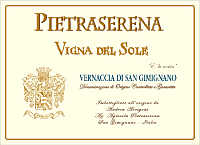
|
|
Vernaccia di San Gimignano Vigna del Sole 2011 |
|
| Pietraserena (Tuscany, Italy) | |
| Grapes: Vernaccia di San Gimignano | |
| Price: € 11.00 | Score: |
| Vernaccia di San Gimignano Vigna del Sole shows a brilliant straw yellow color and nuances of straw yellow, very transparent. The nose denotes intense, clean, pleasing and refined aromas that start with hints of apple, plum and almond followed by aromas of peach, hawthorn, broom and pineapple. The mouth has good correspondence to the nose, a crisp attack and however balanced by alcohol, good body, intense flavors, agreeable. The finish is persistent with flavors of apple, plum and almond. Vernaccia di San Gimignano Vigna del Sole ages in steel tanks. | |
| Food Match: Pasta with fish and crustaceans, Sauteed fish, Sauteed white meat | |
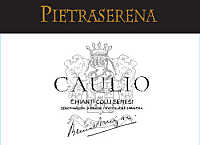
|
|
Chianti Colli Senesi Caulio 2009 |
|
| Pietraserena (Tuscany, Italy) | |
| Grapes: Sangiovese (90%), Malvasia Nera (5%), Syrah (5%) | |
| Price: € 16.00 | Score: |
| Chianti Colli Senesi Caulio shows an intense ruby red color and nuances of garnet red, moderate transparency. The nose denotes intense, clean, pleasing and refined aromas which start with hints of plum, black cherry and dried violet followed by aromas of blueberry, vanilla, tobacco, chocolate and mace. The mouth has good correspondence to the nose, a properly tannic attack and however balanced by alcohol, good body, intense flavors, pleasing roundness. The finish is persistent with flavors of plum, black cherry and blueberry. Chianti Colli Senesi Caulio ages for 12 months in cask and barrique followed by 6 months of aging in bottle. | |
| Food Match: Broiled meat and barbecue, Roasted meat, Stewed meat, Cheese | |
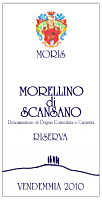
|
|
Morellino di Scansano Riserva 2010 |
|
| Moris Farms (Tuscany, Italy) | |
| Grapes: Sangiovese (90%), Merlot, Cabernet Sauvignon (10%) | |
| Price: € 18.00 | Score: |
| This Morellino di Scansano Riserva shows an intense ruby red color and nuances of ruby red, little transparency. The nose denotes intense, clean, pleasing and refined aromas that start with hints of black cherry, blackberry and plum followed by aromas of violet, blueberry, vanilla, black currant, chocolate, cinnamon and menthol. The mouth has good correspondence to the nose, a properly tannic attack and however balanced by alcohol, good body, intense flavors, agreeable. The finish is persistent with flavors of black cherry, plum and blackberry. This Morellino di Scansano Riserva ages for 12 months in barrique. | |
| Food Match: Broiled meat and barbecue, Roasted meat, Stewed and braised meat, Hard cheese | |
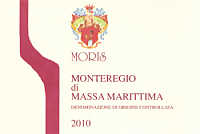
|
|
Monteregio di Massa Marittima Rosso 2010 |
|
| Moris Farms (Tuscany, Italy) | |
| Grapes: Sangiovese (90%), Cabernet Sauvignon (10%) | |
| Price: € 12.50 | Score: |
| Monteregio di Massa Marittima Rosso shows an intense ruby red color and nuances of ruby red, little transparency. The nose reveals intense, clean, pleasing and refined aromas which start with hints of black cherry, plum and black currant followed by aromas of blueberry, violet, blackberry, vanilla, chocolate, cinnamon and menthol. The mouth has good correspondence to the nose, a properly tannic attack and however balanced by alcohol, good body, intense flavors, pleasing roundness. The finish is persistent with flavors of black cherry, plum and black currant. Monteregio di Massa Marittima Rosso ages for 12 months in barrique. | |
| Food Match: Roasted meat, Stewed and braised meat with mushrooms, Hard cheese | |
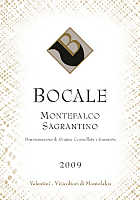
|
|
Montefalco Sagrantino 2009 |
|
| Bocale (Umbria, Italy) | |
| Grapes: Sagrantino | |
| Price: € 19.00 | Score: |
| This Montefalco Sagrantino shows an intense ruby red color and nuances of garnet red, little transparency. The nose denotes intense, clean, pleasing and refined aromas that start with hints of blackberry, plum and violet followed by aromas of black cherry, blueberry, vanilla, chocolate, pink pepper, mace and tobacco. The mouth has good correspondence to the nose, a tannic attack and however balanced by alcohol, full body, intense flavors, agreeable. The finish is persistent with flavors of blackberry, plum and black cherry. This Montefalco Sagrantino ages in cask and barrique for 18 months. | |
| Food Match: Game, Roasted meat, Stewed and braised meat, Hard cheese | |

|
|
Montefalco Sagrantino Passito 2009 |
|
| Bocale (Umbria, Italy) | |
| Grapes: Sagrantino | |
| Price: € 17.00 - 375ml | Score: |
| This Montefalco Sagrantino Passito shows an intense ruby red color and nuances of ruby red, little transparency. The nose reveals intense, clean, pleasing and refined aromas that start with hints of blackberry, plum and dried violet followed by aromas of black cherry, blueberry, vanilla, chocolate, mace and menthol. The mouth has good correspondence to the nose, a tannic and sweet attack, however balanced by alcohol, full body, intense flavors, pleasing roundness. The finish is persistent with flavors of blackberry, black cherry and plum. This Montefalco Sagrantino Passito ages for 24 months in barrique. | |
| Food Match: Dried fruit desserts, Hard cheese | |
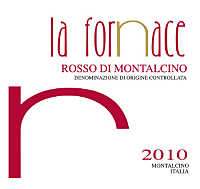
|
|
Rosso di Montalcino 2010 |
|
| La Fornace (Tuscany, Italy) | |
| Grapes: Sangiovese | |
| Price: € 13.00 | Score: |
| This Rosso di Montalcino shows a brilliant ruby red color and nuances of ruby red, moderate transparency. The nose denotes intense, clean, pleasing and refined aromas which start with hints of black cherry, plum and raspberry followed by aromas of violet, blackberry, blueberry, vanilla, tobacco, chocolate and menthol. The mouth has good correspondence to the nose, a properly tannic attack and however balanced by alcohol, good body, intense flavors, pleasing crispness. The finish is persistent with flavors of black cherry, plum and raspberry. This Rosso di Montalcino ages for 13 months in cask. | |
| Food Match: Roasted meat, Broiled meat and barbecue, Braised and stewed meat, Hard cheese | |
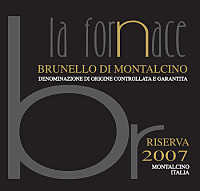
|
|
Brunello di Montalcino Riserva 2007 |
|
| La Fornace (Tuscany, Italy) | |
| Grapes: Sangiovese | |
| Price: € 50.00 | Score: |
| Brunello di Montalcino Riserva shows an intense ruby red color and nuances of garnet red, little transparency. The nose reveals intense, clean, pleasing, refined and elegant aromas which start with hints of plum, black cherry and dried violet followed by aromas of blueberry, blackberry, vanilla, tobacco, chocolate, cinnamon, mace and menthol. The mouth has good correspondence to the nose, a properly tannic attack and however balanced by alcohol, full body, intense flavors, pleasing crispness. The finish is persistent with flavors of plum, black cherry and blueberry. Brunello di Montalcino Riserva ages in barrique for 48 months. | |
| Food Match: Game, Roasted meat, Braised and stewed meat, Hard cheese | |
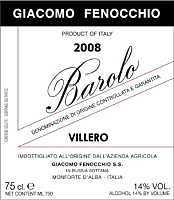
|
|
Barolo Villero 2008 |
|
| Giacomo Fenocchio (Piedmont, Italy) | |
| Grapes: Nebbiolo | |
| Price: € 36.30 | Score: |
| Barolo Villero shows a brilliant ruby red color and nuances of garnet red, moderate transparency. The nose reveals intense, clean, pleasing, refined and elegant aromas which start with hints of cherry, plum and violet followed by aromas of raspberry, vanilla, rose, tobacco, mace, cocoa, cinnamon, anise and menthol. The mouth has good correspondence to the nose, a tannic attack and however balanced by alcohol, full body, intense flavors, pleasing crispness. The finish is persistent with flavors of cherry, plum and raspberry. Barolo Villero ages for 6 months in steel tanks and for 30 months in cask. | |
| Food Match: Game, Roasted meat, Stewed and braised meat, Hard cheese | |
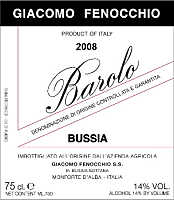
|
|
Barolo Bussia 2008 |
|
| Giacomo Fenocchio (Piedmont, Italy) | |
| Grapes: Nebbiolo | |
| Price: € 36.30 | Score: |
| Barolo Bussia shows a brilliant ruby red color and nuances of garnet red, moderate transparency. The nose reveals intense, clean, pleasing, refined and elegant aromas which start with hints of cherry, plum and dried violet followed by aromas of raspberry, rose, blueberry, vanilla, tobacco, pink pepper, chocolate, cinnamon, mace and menthol. The mouth has good correspondence to the nose, a tannic attack and however balanced by alcohol, full body, intense flavors, pleasing crispness. The finish is very persistent with long flavors of cherry, plum and raspberry. Barolo Bussia ages for 6 months in steel tanks and for 30 months in cask. | |
| Food Match: Game, Roasted meat, Stewed and braised meat with mushrooms, Hard cheese | |
News |
|
In this section are published news and information about events concerning the world of wine and food. Whoever is interested in publishing this kind of information can send us a mail to our address.
|
AquavitaeReview of Grappa, Distillates and Brandy |
|
|
| Distillates are rated according to DiWineTaste's evaluation method. Please see score legend in the "Wines of the Month" section. |

|
|
Grappa di Sagrantino |
|
| Bocale (Umbria, Italy) | |
| (Distiller: Distillerie Collesi) | |
| Raw matter: Pomace of Sagrantino | |
| Price: € 15.00 - 50cl | Score: |
| This grappa is colorless, limpid and crystalline. The nose reveals intense, clean and pleasing aromas of black cherry, blackberry, violet, hazelnut and plum, with perceptible alcohol pungency. In the mouth has intense flavors with perceptible alcohol pungency which tends to dissolve rapidly, good correspondence to the nose, pleasing roundness, balanced sweetness. The finish is persistent with flavors of black cherry, blackberry and plum. This grappa is distilled in a batch bain-marie alembic still. Alcohol 40%. | |
Wine Parade |
|
|
| The best 15 wines according to DiWineTaste's readers. To express your best three wines send us an E-mail or fill in the form available at our WEB site. |
| Rank | Wine, Producer | |
|---|---|---|
| 1 |
| Avvoltore 2009, Moris Farms (Italy) |
| 2 |
| San Leonardo 2006, Tenuta San Leonardo (Italy) |
| 3 |
| Trento Talento Brut Riserva 2007, Letrari (Italy) |
| 4 |
| Confini 2007, Lis Neris (Italy) |
| 5 |
| Franciacorta Pas Dosé Récemment Dégorgé 2006, Cavalleri (Italy) |
| 6 |
| Trento Brut Riserva Methius 2006, Dorigati (Italy) |
| 7 |
| Sagrantino di Montefalco Collepiano 2007, Arnaldo Caprai (Italy) |
| 8 |
| Camartina 2008, Querciabella (Italy) |
| 9 |
| Brunello di Montalcino 2007, Donatella Cinelli Colombini (Italy) |
| 10 |
| Verdicchio dei Castelli di Jesi Classico Superiore Podium 2010, Garofoli (Italy) |
| 11 |
| Adarmando 2009, Tabarrini (Italy) |
| 12 |
| Amarone della Valpolicella Classico Capitel Monte Olmi 2007, Tedeschi (Italy) |
| 13 |
| Offida Rosso Il Grifone 2006, Tenuta Cocci Grifoni (Italy) |
| 14 |
| Batàr 2008, Querciabella (Italy) |
| 15 |
| Gran Masetto 2007, Endrizzi (Italy) |
| |||||||
Privacy Policy | |||||||


| Copyright © 2002-2024 Antonello Biancalana, DiWineTaste - All rights reserved |
| All rights reserved under international copyright conventions. No part of this publication and of this WEB site may be
reproduced or utilized in any form or by any means, electronic or mechanical, without permission in writing from DiWineTaste. |